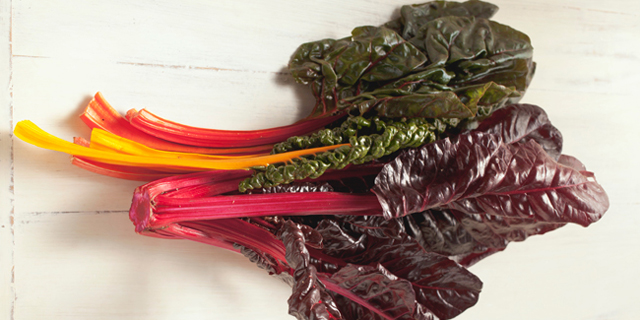Belonging to the same family as spinach, quinoa and beets, chard is also known as a powerhouse of nutrition. A cup of swiss chard, rich in potassium, vitamin A, and vitamin C, comes in at just 7 calories. As an excellent source of antioxidants, including vitamin E, as well as magnesium, vitamin K, and calcium, chard provides anti-inflammatory benefits as well as supports bone health. These tall leafy greens aren’t just delicious, they’re good for you too!
How do I pick the best chard?
Chard, also known as Swiss Chard and Rainbow Chard, is a bitter leafy green that is tall and slightly acidic. It is known for its thick stalk, which comes in a variety of colors from white and red to orange and green. Regardless of stem color, the leaves should be bright and crisp with stalks that are firm and free of any blemishes, cuts or bruises. Steer clear of any bunches with yellowed or browned leaves as well as soggy, wilted, or shriveled stalks.
What can I make with chard?
Chard is a very versatile ingredient, often boiled, sautéd, braised, or enjoyed raw. Add ribboned chard to a hearty soup or stew to add some color and heft. Sauté rainbow chard with a touch of avocado oil, red pepper flakes, and garlic for a colorful side dish and add left overs to a breakfast frittata! Braised Chard with dried cherries and cotija is perfect with a side of juicy pork chops and a little bit of fresh chard thrown into your salad bowl adds a hint of bitterness and crunch.
Chard can be a magnet for little bits of dirt and sand. The easiest way to clean it is to fill up a large bowl with warm water and gently swish the leaves in it, allowing your gorgeous leaves to emerge clean and grit free. Next, stack the leaves on a cutting board and cut out the stems. Then wrap up the leaves as you would a cigar and slice into ribbons in whichever width fits your dish best. Use leaves to punch up a recipe and add stems to a sauté for extra color and crunch.
Store fresh chard in the crisper for 1 to 2 days. To keep chard fresh for up to a week, store chard in a large zip-lock bag ensuring all excess air has been removed. If chard will be dedicated to soups and stews, or if you have a large amount of chard, freezing may be the best option. First prep chard as indicated above, then blanch leaves, drain and pat dry. Toss blanched chard into a freezer safe zip-lock bag or container, remove excess air and store in freezer. Frozen chard will keep fresh for up to a year.
Recipes to try include: Chard Croquettes, Acelgas en Crema (Creamed Swiss Chard), and Chickpea and Chard Stew.


![Making Mealtime Matter with La Familia: Easy Sofrito [Video]](https://thelatinkitchen.com/wp-content/uploads/2015/10/sofrito-shutterstock__0-500x383.jpg)
![Easy Latin Smoothies: Goji Berry Smoothie [Video]](https://thelatinkitchen.com/wp-content/uploads/2015/12/goji_berry-shutterstock_-500x383.jpg)
















![Fun and Fast Recipes: Fiesta Cabbage Salad [Video]](https://thelatinkitchen.com/wp-content/uploads/2015/11/fiesta_cabbage_slaw-shutterstock_-500x383.jpg)









